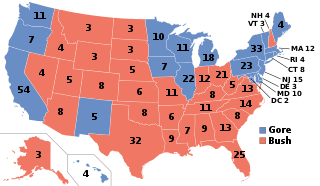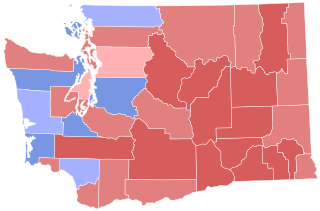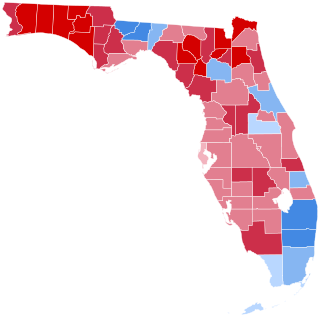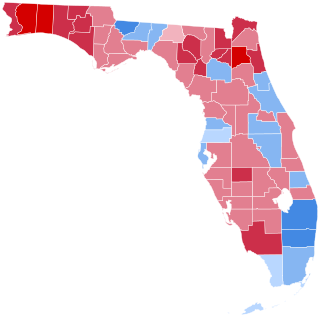
The 2000 United States presidential election was the 54th quadrennial presidential election, held on Tuesday, November 7, 2000. Republican candidate George W. Bush, the governor of Texas and eldest son of the 41st president, George H. W. Bush, won the election, defeating incumbent Vice President Al Gore. It was the fourth of five American presidential elections, and the first since 1888, in which the winning candidate lost the popular vote, and is considered one of the closest U.S. presidential elections, with long-standing controversy about the result. Gore conceded the election on December 13.
Bush v. Gore, 531 U.S. 98 (2000), was a decision of the United States Supreme Court on December 12, 2000, that settled a recount dispute in Florida's 2000 presidential election between George W. Bush and Al Gore. On December 8, the Florida Supreme Court had ordered a statewide recount of all undervotes, over 61,000 ballots that the vote tabulation machines had missed. The Bush campaign immediately asked the U.S. Supreme Court to stay the decision and halt the recount. Justice Antonin Scalia, convinced that all the manual recounts being performed in Florida's counties were illegitimate, urged his colleagues to grant the stay immediately. On December 9, the five conservative justices on the Court granted the stay, with Scalia citing "irreparable harm" that could befall Bush, as the recounts would cast "a needless and unjustified cloud" over Bush's legitimacy. In dissent, Justice John Paul Stevens wrote that "counting every legally cast vote cannot constitute irreparable harm." Oral arguments were scheduled for December 11.

The 2000 United States presidential election recount in Florida was a period of vote recounting in Florida that occurred during the weeks after Election Day in the 2000 United States presidential election between George W. Bush and Al Gore. The Florida vote was ultimately settled in Bush's favor by a margin of 537 votes when the U.S. Supreme Court, in Bush v. Gore, stopped a recount that had been initiated upon a ruling by the Florida Supreme Court. Bush's win in Florida gave him a majority of votes in the Electoral College and victory in the presidential election.

The 2004 Washington gubernatorial election was held on November 2, 2004. The race gained national attention for its legal twists and extremely close finish, among the closest political races in United States election history. Republican Dino Rossi was declared the winner in the initial automated count and again in a subsequent automated recount, but after a second recount done by hand, Democrat Christine Gregoire took the lead by a margin of 129 votes.
The Voter News Service was an exit polling consortium formed in 1990 by six major U.S. news media organizations. Its mission was to provide results for United States presidential elections, so that individual organizations and networks would not have to do exit polling and vote tallying in parallel.

The 2000 presidential campaign of George W. Bush, then governor of Texas, was formally launched on June 14, 1999 as Governor Bush, the eldest son of former President George H. W. Bush, announced his intention to seek the Republican Party nomination for the presidency of the United States in the 2000 presidential election.

The Help America Vote Act of 2002, or HAVA, is a United States federal law which passed in the House 357-48 and 92–2 in the Senate and was signed into law by President Bush on October 29, 2002. The bill was drafted in reaction to the controversy surrounding the 2000 U.S. presidential election, when almost two million ballots were disqualified because they registered multiple votes or no votes when run through vote-counting machines.
The following is a timeline of events during the 2004 U.S. presidential election:
An election exit poll is a poll of voters taken immediately after they have exited the polling stations. A similar poll conducted before actual voters have voted is called an entrance poll. Pollsters – usually private companies working for newspapers or broadcasters – conduct exit polls to gain an early indication as to how an election has turned out, as in many elections the actual result may take hours to count.

In elections in the United States, a provisional ballot is used to record a vote when there are questions about a given voter's eligibility that must be resolved before the vote can count. The federal Help America Vote Act of 2002 guarantees that, in most states, the voter can cast a provisional ballot if the voter states that they are entitled to vote.
Voter verifiable paper audit trail (VVPAT) or verified paper record (VPR) is a method of providing feedback to voters using a ballotless voting system. A VVPAT is intended as an independent verification system for voting machines designed to allow voters to verify that their vote was cast correctly, to detect possible election fraud or malfunction, and to provide a means to audit the stored electronic results. It contains the name of the candidate and symbol of the party/individual candidate. While it has gained in use in the United States compared with ballotless voting systems without it, it looks unlikely to overtake hand-marked ballots.

The 2004 United States presidential election was the 55th quadrennial presidential election, held on Tuesday, November 2, 2004. The Republican ticket of incumbent President George W. Bush and his running mate incumbent Vice President Dick Cheney were elected to a second term, defeating the Democratic ticket of John Kerry, a United States senator from Massachusetts and his running mate John Edwards, a United States senator from North Carolina. As of 2020, this is the only presidential election since 1988 in which the Republican nominee won the popular vote and the only presidential election since 1984 in which the incumbent Republican president won re-election. Due to the higher turnout, both major party nominees set records for the most popular votes received by a major party candidate for president; both men surpassed Reagan's record from 20 years earlier. At the time, Bush's 62,040,610 votes were the most received by any nominee for president, although this record would be broken four years later by Barack Obama. Bush also became the only incumbent president to win re-election after previously losing the popular vote.

The 2004 United States presidential election in Florida took place on November 2, 2004, as part of the 2004 United States presidential election. Voters chose 27 representatives, or electors to the Electoral College, who voted for president and vice president.

The 2004 United States presidential election in Ohio took place on November 2, 2004, and was part of the 2004 United States presidential election. Voters chose 20 representatives, or electors to the Electoral College, who voted for president and vice president.

The 2006 Ohio gubernatorial election was held on November 7, 2006, and was a race for the Governor and Lieutenant Governor of Ohio. Incumbent Governor Bob Taft could not run for re-election, because Ohio governors are limited to two consecutive terms in office. The election was held concurrently with a U.S. Senate election. The general election for governor pitted Ohio Secretary of State Ken Blackwell, the Republican nominee, against United States Congressman Ted Strickland of Ohio's 6th congressional district, the Democratic nominee. Their running mates were former Ohio Attorney General Lee Fisher on the Democratic ticket and State Representative Tom Raga on the Republican ticket.
Warren J. Mitofsky was an American political pollster.

The 2000 United States presidential election in Florida took place on November 7, 2000, as part of the nationwide presidential election. Florida, a swing state, had a major recount dispute that took center stage in the election. The outcome of the 2000 United States presidential election was not known for more than a month after balloting because of the extended process of counting and recounting Florida's presidential ballots. State results tallied on election night gave 246 electoral votes to Republican nominee Texas Governor George W. Bush and 255 to Democratic nominee Vice President Al Gore, with New Mexico (5), Oregon (7), and Florida (25) too close to call that evening. Gore won New Mexico and Oregon over the following few days; but the result in Florida was to be decisive, regardless of how those two states had voted.

The Bradley effect is a theory concerning observed discrepancies between voter opinion polls and election outcomes in some United States government elections where a white candidate and a non-white candidate run against each other. The theory proposes that some white voters who intend to vote for the white candidate would nonetheless tell pollsters that they are undecided or likely to vote for the non-white candidate. It was named after Los Angeles mayor Tom Bradley, an African-American who lost the 1982 California gubernatorial election to California attorney general George Deukmejian, a white person, despite Bradley being ahead in voter polls going into the elections.
An election verification exit poll (EVEP) is a relatively new concept in polling, intended to improve the accuracy of exit polls to such an extent that they can be used to verify election results. Traditional (media) exit polling relies on small samples, wheres EVEPs propose to use larger samples.

The 2020 United States presidential election in Arizona was held on Tuesday, November 3, 2020, as part of the 2020 United States presidential election, in which all 50 states and the District of Columbia participated. Arizona voters chose 11 electors to represent them in the Electoral College via a popular vote pitting incumbent Republican President Donald Trump of Florida and his running mate, incumbent Vice President Mike Pence of Indiana, against Democratic challenger and former Vice President Joe Biden of Delaware and his running mate, United States Senator Kamala Harris of California. The Libertarian nominees were also on the ballot.












